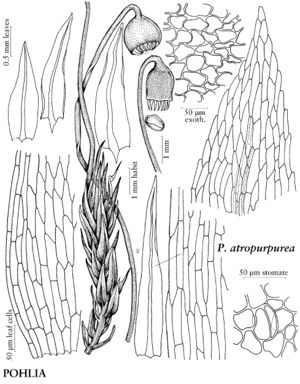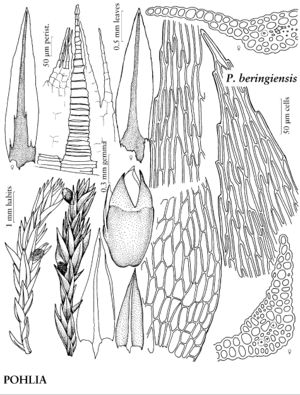Pohlia
Sp. Musc. Frond., 171. 1801.
| Taxon | Illustrator ⠉ | |
|---|---|---|
 | Pohlia annotina | Patricia M. Eckel |
 | Pohlia atropurpurea | Patricia M. Eckel |
 | Pohlia beringiensis | Patricia M. Eckel |
| ... further results | ||
Plants very small to large, as scattered plants or deep, sometimes extensive, turfs. Stems 0.1–10 cm, not complanate-foliate, often bearing subfloral innovations below the gametangia. Leaves with dorsal and lateral not differentiated, erect to spreading, narrowly lanceolate to ovatelanceolate [rarely linear-lanceolate], 0.6–3.5 mm; base decurrent or not; margins plane (strongly revolute in P. cardotii and P. crudoides), finely serrate to serrulate near apex, rarely entire; apex acute (sometimes short-acuminate in P. melanodon); costa ending well before apex, subpercurrent, percurrent, or rarely short-excurrent; distal medial laminal cells elongate-hexagonal, rhombic, or linear-rhomboidal, sometimes narrowly vermicular; marginal cells undifferentiated or slightly narrower and longer than medial cells. Specialized asexual reproduction common, by spheric to ovoid rhizoidal tubers or axillary filiform to bulbiform gemmae. Sexual condition dioicous, paroicous, or rarely autoicous; perigonia and perichaetia terminal (perigonia rarely lateral in P. longibracteata); perigonial leaf apex acute to long-acuminate; perichaetial leaves same size as vegetative leaves or sometimes strongly differentiated, lanceolate to narrowly linear-lanceolate. Seta single (multiple in P. robertsonii), stramineous to orangebrown, straight or bent. Capsule inclined 0–180°, narrowly cylindric to broadly pyriform or urceolate, 1–6 [–10] mm, neck sometimes 1+ times urn length; exothecial cells near mouth in 1–3+ rows, medial cell-walls straight or sinuate; stomata superficial to immersed; annulus absent or present, revoluble; operculum convex, short to long-conic, sometimes short-rostrate; peristome double [rarely absent], 4: 2:4–6 (–8); exostome white, pale-yellow to brown, or sometimes dark reddish-brown, teeth triangular to lanceolate, sometimes irregular [rarely reduced or absent], trabeculate or not, pitted basally, coarsely papillose distally (coarsely papillose throughout in P. crudoides); endostome basal membrane low to high, sometimes scarcely exceeding capsule rim, segments narrow to wide, strongly to weakly or scarcely keeled, rarely reduced to rudimentary projections, broadly to narrowly perforate or less often not, cilia absent or 1–3.
Distribution
North America, Mexico, Central America, South America, Europe, Asia, Africa, Pacific Islands (New Zealand), Australia
Discussion
Species ca. 85 (32 species in the flora).
Selected References
None.
Lower Taxa
Key
| 1 | Axillary gemmae present | > 2 |
| 1 | Axillary gemmae absent | > 14 |
| 2 | Gemmae with peglike leaf primordia | > 3 |
| 2 | Gemmae with broadly laminate (leaflike) leaf primordia | > 8 |
| 3 | Plants glossy | > 4 |
| 3 | Plants dull | > 5 |
| 4 | Gemmae oblong-linear to linear-vermicular, leaf primordia elongate, erect. | Pohlia proligera |
| 4 | Gemmae isodiametric to oblong, leaf primordia inconspicuous, incurved. | Pohlia andrewsii |
| 5 | Gemmae oblong, knobby in outline, leaf primordia absent. | Pohlia flexuosa |
| 5 | Gemmae spheroid, obconic, or linear, not knobby in outline, leaf primordia present | > 6 |
| 6 | Gemmae spheroid. | Pohlia camptotrachela |
| 6 | Gemmae oblong or obconic to linear | > 7 |
| 7 | Gemmae oblong or obconic, leaf primordia 2-5, conspicuous. | Pohlia annotina |
| 7 | Gemmae narrowly linear, leaf primordia 1 or 2, inconspicuous. | Pohlia flexuosa |
| 8 | Gemmae 2-8 per leaf axil, narrowly elongate, oblong-bulbiform, or obconic | > 9 |
| 8 | Gemmae 1 or 2 per leaf axil, bulbiform | > 11 |
| 9 | Gemmae elongate, extending beyond leaves. | Pohlia tundrae |
| 9 | Gemmae oblong, obconic, or spheroid, shorter than leaves | > 10 |
| 10 | Gemmae obconic to oblong. | Pohlia andalusica |
| 10 | Gemmae spheroid to obovate. | Pohlia bulbifera |
| 11 | Gemmae oblong or elliptic to subglobose, leaf primordia small, stiff, restricted to apex or rarely 1 or 2 proximally. | Pohlia filum |
| 11 | Gemmae bulbiform, leaf primordia large, flexuose, at gemma apex and proximally | > 12 |
| 12 | Plants dull; leaves slightly contorted when dry. | Pohlia rabunbaldensis |
| 12 | Plants glossy; leaves unaltered when dry | > 13 |
| 13 | Plants dark green to reddish; leaves ± spreading. | Pohlia drummondii |
| 13 | Plants whitish; leaves ± erect. | Pohlia beringiensis |
| 14 | Leaf margins strongly recurved to revolute | > 15 |
| 14 | Leaf margins plane | > 16 |
| 15 | Leaves narrowly long-lanceolate; medial laminal cells linear-hexagonal, walls thin, not porose. | Pohlia crudoides |
| 15 | Leaves ovate-lanceolate; medial laminal cells rhombic, walls thick, ± porose. | Pohlia cardotii |
| 16 | Sexual condition paroicous | > 17 |
| 16 | Sexual condition dioicous (very rarely paroicous) | > 22 |
| 17 | Setae multiple. | Pohlia robertsonii |
| 17 | Setae single | > 18 |
| 18 | Medial laminal cells lax, hexagonal or broadly rhombic, walls thin. | Pohlia obtusifolia |
| 18 | Medial laminal cells firm, hexagonal to rhomboidal or vermicular, walls thin or thick | > 19 |
| 19 | Plants dull; laminal cells hexagonal to rhomboidal | > 20 |
| 19 | Plants shiny; laminal cells linear-vermicular | > 21 |
| 20 | Capsule necks 1/2 urn length; endostome segments broadly perforate, cilia present. | Pohlia nutans |
| 20 | Capsule necks 1/2 to 1 time urn length; endostome segments narrowly to not perforate, cilia absent to rudimentary, rarely long. | Pohlia elongata |
| 21 | Leaves long-lanceolate; endostome segments narrowly to not perforate, cilia absent to rudimentary. | Pohlia longicolla |
| 21 | Leaves lanceolate to elliptic; endostome segments broadly perforate, cilia present, short to long. | Pohlia cruda |
| 22 | Capsules inclined 0-20°; endostome segments weakly keeled, slightly tapered, cilia absent. | Pohlia erecta |
| 22 | Capsules inclined 35-180°; endostome segments distinctly keeled, tapered apically, cilia present or absent | > 23 |
| 23 | Leaf bases long-decurrent; medial laminal cells rhombic to rhomboidal. | Pohlia ludwigii |
| 23 | Leaf bases not or scarcely decurrent; medial laminal cells linear, hexagonal, or rhomboidal | > 24 |
| 24 | Capsules narrowly cylindric, inclined 35-90°; endostome segments narrowly to not perforate, cilia absent to rudimentary. | Pohlia bolanderi |
| 24 | Capsules pyriform to urceolate, inclined 80-180°; endostome segments broadly perforate, cilia present | > 25 |
| 25 | Annulus present; exothecial cells rectangular | > 26 |
| 25 | Annulus absent; exothecial cells isodiametric | > 28 |
| 26 | Plants green or rarely reddish, dull; laminal cells short- hexagonal. | Pohlia nutans |
| 26 | Plants pale green to green, glossy; laminal cells linear-rhomboidal to linear-vermicular | > 27 |
| 27 | Plants somewhat glossy; leaf margins serrulate at apex; medial laminal cells 65-110 µm. | Pohlia lescuriana |
| 27 | Plants very glossy; leaf margins coarsely serrate at apex; medial laminal cells 110-145 µm. | Pohlia pacifica |
| 28 | Medial laminal cells laxly rhomboidal | > 29 |
| 28 | Medial laminal cells linear-hexagonal to linear-rhomboidal or broadly rhomboidal | > 31 |
| 29 | Plants very small, reddish; stems 0.2-0.4 cm; stomata superficial. | Pohlia atropurpurea |
| 29 | Plants small to large, green to whitish, rarely reddish when very large; stems 0.3-10 cm; stomata deeply immersed | > 30 |
| 30 | Plants dark green; stems 0.3-1 cm. | Pohlia melanodon |
| 30 | Plants whitish, sometimes reddish when very large; stems 0.8-10 cm. | Pohlia wahlenbergii |
| 31 | Plants medium-sized to large; leaves wide-spreading; perigonial leaves to 6 mm. | Pohlia longibracteata |
| 31 | Plants small to rarely medium-sized; leaves erect to erect-spreading; perigonial leaves to 3 mm | > 32 |
| 32 | Stomata superficial or slightly immersed | > 33 |
| 32 | Stomata immersed | > 34 |
| 33 | Stems 0.3-1.5 cm; leaves erect-spreading; medial laminal cells linear, 6-9 µm wide. | Pohlia brevinervis |
| 33 | Stems 0.2-0.4 cm; leaves erect-spreading to spreading; medial laminal cells laxly and broadly rhomboidal, 10-12 µm wide. | Pohlia atropurpurea |
| 34 | Stems green to pale orange or pink; leaves spreading; plants dull. | Pohlia columbica |
| 34 | Stems cherry red; leaves erect; plants glossy. | Pohlia vexans |
"narrow" is not a number.